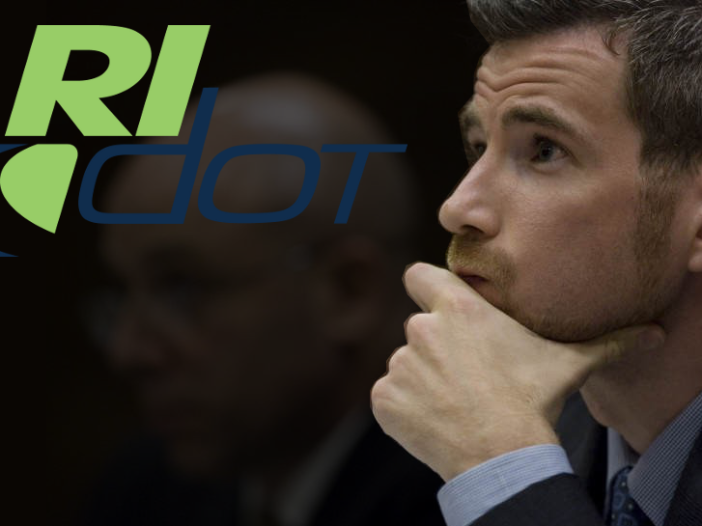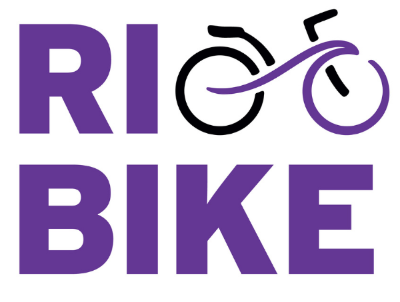
We had two meetings last week with Deputy Director of RIDOT, Pete Garino. One was a roundtable with a number of other advocates for biking & transit, one was one-on-one. There are changes afoot at RIDOT, and we wanted to let you know what’s going on.
First of all, the basic idea the new RIDOT leadership is pushing in its 10-year RhodeWorks proposal is to raise extra money through truck tolls to aggressively repair the state’s structurally-deficient bridges and get us out of the “death spiral” of nothing but emergency repairs. With public infrastructure, it’s often the case that doing proactive maintenance & repairs saves boatloads of money in the longer run, and RIDOT wants to do that.
But what about bikes? In the administration’s proposed breakdown of funding in the RhodeWorks proposal, there is $128 million for bike/ped infrastructure over the next 10 years, which is about 3x more than we’re getting currently. In addition to keeping that funding in there, we’ve been clear with DOT that when they’re resurfacing roads and bridges, they should stripe bike lanes wherever appropriate. To focus that process, we are eager to work with Statewide Planning, DOT, DEM, and local governments to ensure that good bike plans are in place so that DOT knows where to put bike lanes.
Some specific questions that we asked Garino, and his answers:
- The George Redman Linear Park is now open all the time, and there will be a dedication sometime this fall.
- The repaving of the East Bay Bike Path has been changed from a complete resurfacing of the southern half of the path to a spot-fixing contract to fix the worst locations where tree roots have buckled the pavement.
- The 195 bike/ped bridge in Providence is indeed postponed for now with no defined construction date, which is very disappointing. There may be discretionary funds above and beyond the mainline funding in RhodeWorks that may be applied to this project, and we will push for that.
- We asked Garino about the status of bike projects that are already in the Transportation Improvement Plan (TIP), the important four-year plan for where federal transportation money gets spent. RIBike’s priorities are completing & connecting our bike paths (especially the Blackstone Bikeway, the Woonasquatucket Greeneway, and connections at either end of both the Washington Secondary Trail and the South County Bike Path). Garino’s priority is section 1A of the Blackstone Bikeway, which would connect India Point Park to the end of Waterman Street behind Gano Park and Eastside Marketplace (bypassing the need for bicyclists to ride on Gano Street). We impressed upon him that one of the highest priorities for RIBike is the connection between the Washington Secondary Trail and downtown, perhaps connecting with the Woonasquatucket Greenway, and he seemed to take that to heart. There were many representatives from South County present at the roundtable as well, and Garino said the latest study on Phase 4 of the South County Bike Path will be complete soon.
- The TIP process itself is changing from being a once-every-four-years process that municipalities & agencies like RIPTA submit priorities for to a process more managed by RIDOT that every year updates plans for the next ten years. The Transportation Advisory Commission (TAC) will continue to be an important public body in this process, but the prioritization will be more centralized. We have concerns that this process could lose some of the local expertise of the municipal prioritization, but believe that the timing change is a good one.
- RIDOT is in the early stages of a reorganization to be more project-management focused. In general, we believe this will be a good thing for bikes and for the efficient use of funds. However, it will always be important for us all to stay involved in planning processes and close to project managers to ensure that robust bike infrastructure is built where we all need it.
- The previous director of RIDOT held quarterly roundtables such as the one that happened last week. After some uncertainty this spring and summer, we now have confirmation that those roundtables will continue to happen quarterly, with Garino (Deputy Director of RIDOT) rather than Peter Alviti (Director of RIDOT). While it is somewhat disappointing that the #1 person at RIDOT is not as engaged as the previous #1 was, Garino is a strong voice in the leadership team and we look forward to working with him further.
- As has been the case previously, DEM maintains many of the state’s bike paths, mowing them and keeping them clear. Because of that role, DEM collaborates with DOT to some extent in the planning of future bike routes.
- The rebuilding of the 6/10 Connector through the West Side of Providence is a big piece of RhodeWorks, as a section that has many bridges in need of repair. $800 million of the $4.75 billion proposed in RhodeWorks is just for this section of highway. RIBike supports the proposal to replace the existing separated highway in this corridor with a less expensive, more permeable boulevard, that would provide better bike connections and less harshly sever the neighborhoods on either side of it from each other. RIDOT has expressed that they are very open-minded about how to rebuild this corridor, with possibilities for a boulevard and for bus rapid transit.
- Finally, Garino repeatedly used the metaphor of the state needing to “eat our vegetables” (i.e. invest in bridge maintenance) before we get “dessert” (such as bike paths). While we recognize the importance of bridge investment, we are alarmed that RIDOT considers safe streets for all road users as a “nice to have” rather than a “must have”. We will continue to advocate for a more multimodal perspective from RIDOT.
It is part of RIBike’s mission to work closely with RIDOT to improve bike infrastructure around the state. We will continue to hold such meetings and communication with our members about any updates.

